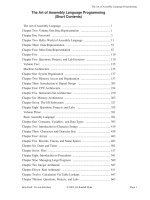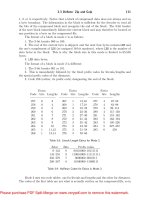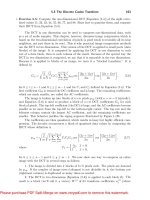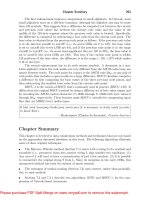Tài liệu A Comparison of High-Level Full-System Power Models ppt
Bạn đang xem bản rút gọn của tài liệu. Xem và tải ngay bản đầy đủ của tài liệu tại đây (466.4 KB, 5 trang )
A Comparison of High-Level Full-System Power Models
Suzanne Rivoire
Sonoma State University
Parthasarathy Ranganathan
Hewlett-Packard Labs
Christos Kozyrakis
Stanford University
Abstract
Dynamic power management in enterprise environments re-
quires an understanding of the relationship between resource
utilization and system-level power consumption. Power mod-
els based on resource utilization have been proposed in the
context of enabling specific energy-efficiency optimizations on
specific machines, but the accuracy and portability of different
approaches to modeling have not been systematically compared.
In this work, we use a common infrastructure to fit a family
of high-level full-system power models, and we compare these
models over a wide variation of workloads and machines, from
a laptop to a server. This analysis shows that a model based
on OS utilization metrics and CPU performance counters is
generally most accurate across the machines and workloads
tested. It is particularly useful for machines whose dynamic
power consumption is not dominated by the CPU, as well as
machines with aggressively power-managed CPUs, two classes
of systems that are increasingly prevalent.
1 Introduction
In order to maximize energy efficiency, whether in a single
system or over an ensemble of systems, users and data center
operators need to understand the relationship between resource
usage and system-level power consumption. This understanding
enables such optimizations as consolidating workloads on as
few machines as possible and turning others off [6, 16], since
current hardware is highly inefficient at low utilization [1]. It
also includes dynamically adjusting power budgets within an
enclosure or rack to enable a data center’s power provisioning
infrastructure to be designed less conservatively [5, 18]. While
several types of full-system power models have been proposed,
often in the context of enabling a particular optimization,
they have not been systematically compared over a variety of
software workloads and hardware platforms.
The desirable properties of a full-system model suitable for
this type of online use are as follows:
Accuracy: The model must be accurate enough to allow the
desired energy savings. In this work, we define accuracy
as less than 10% error in the average case, although higher
accuracies are certainly better and may be necessary for some
optimizations.
Speed: The model must generate predictions quickly enough to
be used by energy-saving policies; this work assumes that one
sample per second is sufficiently fast.
Generality and portability: The modeling framework should
be suitable for as many systems as possible, encompassing
mobile, desktop and server systems; different processor families
and memory and storage technologies; and different power
footprints and dynamic ranges. It should also allow for different
allocations of power consumption among components, rather
than assuming that a particular component will dominate
the system. Furthermore, generating models for a new system
should not require exhaustive design space exploration or tuning.
Inexpensive: Generating and using the model should not
require expensive or intrusive infrastructure.
Simple: All other things being equal, simple models should
be preferred to complex ones, both in terms of the number of
inputs and the complexity of the relationship between inputs
and outputs.
In this work, we use a common infrastructure to generate
several high-level full-system power models for a wide range of
workloads and machines, and we compare the accuracy of these
models in each instance. This analysis illuminates the trade-offs
between simplicity and accuracy, as well as the limitations of
each type of model. We begin with a discussion of previously
proposed approaches to power modeling in Section 2, before
defining the models compared in this work and describing the
infrastructure used to generate them in Section 3. Section 4
then describes the software and hardware platforms used for
their evaluation. Section 5 presents the results of the evaluation,
which are discussed qualitatively in Section 6. Section 7
presents the overall conclusions and directions for future work.
2 Related Work
Approaches to real-time power modeling fall into two cate-
gories: detailed analytical power models, and high-level black-
box models. Detailed analytical processor power models based
on CPU performance counters have been proposed by Joseph
and Martonosi [9] and by Isci and Martonosi [8]. These models
are real-time and highly accurate, but they model only the pro-
cessor component, and they rely on detailed microarchitectural
knowledge of a particular processor, limiting their generality
and portability. Kadayif et al. used performance counters to
model the energy consumption of the Sun UltraSPARC memory
hierarchy, with the goal of synthesizing this information into
virtual “energy counters” [10]. These models all provide
a middle ground between highly detailed simulation-based
models and the simple real-time models evaluated in this paper.
The other type of real-time power model is the high-level,
black-box model, which sacrifices some accuracy in order to
avoid relying on detailed knowledge of the hardware’s imple-
mentation. Such models have been developed for processors,
single systems, and groups of systems in enterprise environ-
ments. At the processor level, Bellosa’s power models were
some of the first to correlate power consumption with perfor-
mance counters, finding linear relationships between processor
power consumption and several performance counters [2]. Con-
treras and Martonosi created a highly accurate black-box linear
model of the power consumption of an Intel XScale processor
and its memory system [3]. These models are simple, fast, and
low-overhead, but they do not model the full-system power
consumption, and it is unclear how general and portable they are.
At the full-system level, Li and John used performance coun-
ters to generate models for individual OS routines, concluding
that models using performance counters without higher-level
software knowledge were not consistently accurate [11].
Cignetti et al. developed a full-system energy model for a Palm
IIIE PDA as a linear function of the power states of its eight
major components. In the server environment, Ranganathan et
al. implemented dynamic power budgeting optimizations [18]
by creating lookup tables relating power and performance to
system resource utilization, and they developed a methodology
for porting a model generated on one machine to another in the
same family [17]. Fan et al. implemented similar optimizations
using models based on CPU utilization alone: one linear, and
the other using an empirical power term [5]. To facilitate
server consolidation, Heath et al. developed linear models that
used OS-reported CPU, memory, and disk utilization for two
different types of servers [6]. Finally, Economou et al. used
OS-reported component utilizations and CPU performance
counters to model the power consumptions of a blade and an
Itanium server [4]. This study evaluates the latter approaches
for a wider range of systems and workloads.
3 Model Development
To develop the power models for each system, we use Man-
tis [4], a non-intrusive infrastructure for providing fast and
accurate full-system power predictions. Mantis requires a
one-time model fitting, in which the system is plugged into
an AC power meter, and power readings and software metrics
are collected once per second while the system runs a special
calibration workload. The software metrics are then fitted to
the power readings, and can be used thenceforth to predict
power without the presence of a meter. The special calibration
workload includes programs that selectively stress each of the
major consumers of dynamic power (CPU, memory, and disk)
at varying levels of utilization [13, 19]. The network subsystem
is not yet a noticeable consumer of dynamic power [4, 14], and
thus was not stressed by the calibration suite. This approach
to calibration, stressing each component in isolation, implicitly
assumes that the components are linearly independent; this
assumption restricts the complexity of the models that can be
generated. Furthermore, the calibration suite is biased toward
the idle case; if the CPU, memory, and disk tests take equal
amounts of time, each component is idle for two-thirds of the
calibration suite, and we do not correct for this. The benchmarks
that we use to evaluate the models in Section 5, however, operate
at high utilization and will thus illustrate the worst-case errors.
3.1 Model inputs
We compare five different types of models in this work, which
vary in the inputs used and the complexity of the model
equations. The first model simply predicts a constant power
C
0
, regardless of resource utilization; this C
0
is the mean
power during the calibration suite. This model is valuable for
two reasons: first, it provides a baseline or null model for the
utilization-based models. Second, it is similar to the method of
estimating a system’s power based on its manufacturer specifi-
cations, although it will probably yield better predictions, since
it is the average power during use rather than a conservative
estimate. Using only full-system power measurements, as we do
here, it is impossible to delineate each component’s contribution
to the idle power C
0
; we can only model the change in power
correlated to each component’s utilization.
The second and third models, proposed by Fan et al. [5]
use only CPU utilization as input to the model. The first of
these is linear in CPU utilization, yielding an equation of the
form P
pred
= C
0
+ C
1
× u
cpu
. The second adds an empirical
term that those authors found to improve accuracy, yielding an
equation of the form P
pred
= C
0
+ C
1
× u
cpu
+ C
2
× u
r
cpu
,
where C
2
and r are additional fitted parameters.
The fourth model, similar to that proposed by Heath et al.,
is a linear model that uses disk utilization in addition to CPU
utilization [6]. To model the dynamic power consumption of
the disk, we also evaluated models that used the number of I/O
requests and the number of disk transfers as parameters in order
to have some idea of the balance of random vs. sequential I/O.
However, these models were no more accurate than those simply
using disk utilization, which we present here. The final model,
which we proposed [4], adds CPU performance counters to the
OS-reported CPU and disk utilization. In the interest of simplic-
ity and low overhead, we use only as many counters as can be
collected at one time, without time-multiplexing; for most of our
systems, the maximum number of counters is 4. In general, the
counters we examined correspond to the memory bandwidth, the
amount of instruction-level parallelism, the activity of the cache
hierarchy, and the utilization of the floating-point unit. The
exact counters available are highly implementation-dependent,
as are the weights assigned to them in the models.
4 Evaluation Methodology
To evaluate the generality of the models, we used a wide variety
of machines and benchmarks. The machines studied were:
• An 8-core (2 quad-core) Xeon server with 32 GB FBDIMM
memory
• A server with 4 Itanium 2 CPUs and 1 GB memory
• A mobile fileserver with a high-end mobile CPU and 13
SATA laptop disks [20], at its highest and lowest CPU clock
frequencies
• The same machine with just one disk, at its highest and
lowest CPU clock frequencies
• A 2005-era AMD Turion laptop with 384 MB of memory
These machines span three different processor families (Core
2 Duo/Xeon, Itanium, and Turion) from two different manufac-
turers. Their memories include mobile memory, desktop/server
DDR2 memory, and FBDIMM technology, and their disks
include both mobile and enterprise disks. At the full-system
level, the machines vary in the balance of power among their
components and in the amount of variation in their dynamic
power consumption, from the CPU-dominated Itanium server
to the disk-intensive mobile fileserver.
The benchmarks used were:
• The SPEC CPU integer and floating-point suites
• The SPEC JBB benchmark
• The “stream” memory-stress synthetic benchmark [12]
• I/O-intensive benchmarks, which varied by system. For most
machines, the ClamAV antivirus scanner was used, with
multiple copies instantiated if necessary to exercise multiple
disks. Two machines required different programs: on the
mobile fileserver, ClamAV saturated the CPU before the
disk subsystem, so the Nsort [15] sorting program was used
instead. For the Itanium, the SPECweb benchmark was used
to provide a combination of disk and network I/O.
We evaluate the models by both generating model predictions
and measuring the full-system (wall) power with a power meter,
and then comparing the predictions with the measured power.
These measurements and comparisons were also done once per
second, which is the limit of many interfaces to system utiliza-
tion metrics (e.g. perfmon, sar, etc.). This granularity is suffi-
cient for the cross-system optimizations described in Section 1.
5 Results
Figure 1 shows the mean absolute percentage error for each
model across all of the machine configurations tested. The 90
th
percentile absolute error, which is omitted here for brevity, is
not qualitatively different and is documented in [19]. The first
cluster of columns shows the error for the calibration suite that
was used to fit the models; the remaining clusters show the error
for each of the benchmarks described in the previous section.
Within each cluster, the leftmost bar denotes the error from
the constant (utilization-independent) power model, followed
by the linear and empirical CPU-utilization-based models, the
linear CPU- and disk-utilization-based model, and finally the
2
0
2
4
6
8
10
12
14
16
Calib
SPECfp
SPECint
SPECjbb
stream
I/O
Mean Absolute % Error
Const
CPUut-Lin
CPUut-Emp
CPU+Disk
Perfctr
Figure 1: Overall mean absolute error for the generated models
over all benchmarks and machine configurations.
0
5
10
15
20
25
calib
SPECfp
SPECint
SPECjbb
stream
clamAV
Mean Absolute % Error
Const
CPUut-Lin
CPUut-Emp
CPU+Disk
Perfctr
Figure 2: Mean absolute percentage error for the generated
models on the Xeon server.
linear model using CPU performance counters in addition to the
OS-reported metrics.
These aggregate results show that all of the utilization-based
models are superior to the constant model, showing that re-
source utilization metrics correlate to power consumption. The
most detailed model, which is the performance-counter-based
model, is the best model overall for every benchmark, with the
lowest mean and 90
th
percentile absolute errors. However, all
of the models predict power within 10% mean accuracy for
each benchmark, averaged over all configurations. These results
suggest that even the simple, linear CPU-utilization-based
model would meet the accuracy goal outlined in Section 1.
The rest of this section examines the results for some of the
individual machines, showing where more detailed models
are most necessary; again, the full results for all machines,
including the full model equations, are documented in [19].
5.1 Xeon server
Figure 2 shows the mean absolute percentage error for the dif-
ferent models on the Xeon server. All of the utilization-based
models fit the calibration suite, which is biased toward the idle
case, with very little error. However, the errors for the SPEC
benchmarks and stream are much higher. In the case of the
SPEC benchmarks, which are CPU-intensive, the performance-
counter-based model is the best of the linear models, but the
linear models are all outperformed by the empirical CPU-
utilization-based model. Figure 3 shows the measured power
0
50
100
150
200
250
300
350
400
0 100 200 300 400 500 600 700 800
CPU Utilization % (8 cores)
Measured Power (W)
Figure 3: Measured power versus CPU utilization for the 8-core
Xeon server during the calibration suite. Note that memory
and disk utilization were not constant over this dataset and
that the calibration suite does not fully stress all components
simultaneously.
during the calibration suite versus CPU utilization, a curve that
is close to linear for utilizations up to 500% (5 cores) and then
leveling off. This behavior is captured by the empirical equation
and may be a result of the shared resources on the two quad-core
Xeon chips used in this server; we found that the maximum num-
ber of references to the shared L2 cache increases very slowly at
high utilization, since this resource can be highly utilized by just
two cores. This empirical model was originally proposed in a
multicore server environment [5], and its ability to model bottle-
necks on shared resources is well suited to these processors.
The stream benchmark’s power consumption is best modeled
by the performance-counter-based models. The Xeon server
has 32 GB of FBDIMM memory, which has a dynamic power
variation of up to 100 W. Since the stream benchmark is
memory-intensive without commensurate CPU activity, and
since only the performance-counter-based model uses memory
activity as a parameter, it is no surprise that the performance-
counter-based models are most accurate. Finally, the models are
all quite accurate for the disk-intensive ClamAV benchmark,
since the disk contributes a very small fraction of the system’s
dynamic power consumption.
5.2 Mobile fileserver
Figures 4 and 5 show the mean absolute percentage error of
the mobile fileserver at its highest and lowest clock frequencies
(separate models were generated for each frequency). For the
SPEC benchmarks, the disk- and performance-counter-based
models perform much better than the models based on CPU
utilization alone. The usefulness of disk information is counter-
intuitive, since neither of these benchmarks has significant disk
utilization. The reason that the disk information is helpful is that
both CPU and disks contribute highly (and about equally) to the
dynamic power of this system, and they are not highly correlated
to each other. Forcing the CPU utilization to explain the entire
dynamic power variation results in over-predicting the power
consumption when the disk utilization is low, particularly for
the less flexible linear model. Performance counter information
further improves the power predictions; the reason is that this
CPU uses aggressive clock gating to shut down unused units,
even at high utilization [7], so power depends on how the
CPU is utilized—-a more complex question than whether it is
active at all, which is what CPU utilization reports. This effect
is particularly pronounced with SPECjbb, which runs at full
3
0
5
10
15
20
25
calib
SPECfp
SPECint
SPECjbb
stream
Nsort
Mean Absolute % Error
Const
CPUut-Lin
CPUut-Emp
CPU+Disk
Perfctr
Figure 4: Mean absolute percentage error of the generated mod-
els on the mobile fileserver at its highest frequency (2.3 GHz).
0
5
10
15
20
25
calib
SPECfp
SPECint
SPECjbb
stream
Nsort
Mean Absolute % Error
Const
CPUut-Lin
CPUut-Emp
CPU+Disk
Perfctr
Figure 5: Mean absolute percentage error of the generated
models on the mobile fileserver at its lowest frequency (1 GHz).
utilization but with much lower instruction-level parallelism
than SPECint and SPECfp, even though we ran SPECjbb on
two cores and the CPU suite on just one.
The accuracies at the lowest frequency are much lower than
at the highest frequency. The reason is that the CPU becomes
a smaller consumer of dynamic power at this frequency; its dy-
namic power is dwarfed by the disk’s and is slightly lower than
the memory’s. The CPU-utilization-based models, which are
forced to attribute the entire dynamic power variation of the sys-
tem to the component with the lowest variation, yield predictions
worse than the constant model for the CPU-intensive bench-
marks; paradoxically, they predict the power well for stream,
since their overpredictions of CPU power end up being fairly
close to the dynamic memory power. Overall, this configuration
shows the difficulty of developing power models for systems
where the CPU does not dominate the dynamic power. One
reason for this difficulty is the lack of detailed memory and disk
metrics analogous to CPU performance counters, which would
help model these components’ dynamic power consumption.
6 Discussion
The results presented in the previous section show that simple,
high-level models can be used to accurately predict power for a
wide range of systems and workloads. They also highlight some
potential pitfalls in developing power models:
• CPU utilization as a proxy for power consumption. CPU
utilization is often considered a first-order proxy for dynamic
power consumption, the logic being that the CPU is the
dominant consumer of dynamic power and that its power is
determined largely by its power state (active or sleeping). For
systems that are not CPU-dominated (e.g. fileservers, some
laptops) or workloads that are not CPU-intensive (e.g. stream-
ing, sorting), these assumptions break down. They also break
down in two other situations, even for systems and workloads
that are CPU-dominated. The first is in processors with
shared resources, such as multicore processors, where power
consumption is not a linear function of utilization. The sec-
ond is in aggressively power-managed processors, where the
active-state power consumption may vary widely depending
on what the CPU is actually doing. Since current hardware
trends are toward less CPU-dominated systems [1], multicore
processors, and aggressive power management, OS-reported
CPU utilization will be a less and less useful proxy for power
consumption.
• Assuming that more information yields a better model.
If a large component of the system’s dynamic power is not
directly accounted for by the power models, less detailed
models may actually yield better results, as seen with the
stream benchmark on the mobile fileserver. In general,
models’ relative accuracy will be unpredictable if a large
component of dynamic power is not modeled.
• Blindly applying performance counters across systems.
While the same basic group of performance counters
(unhalted clock cycles, instructions retired/ILP, last-level
cache references, memory bandwidth, and floating-point
instructions executed) can be used to model power across a
wide variety of systems, the nuances of how these counters
are defined from platform to platform do matter. To yield
an accurate model, a performance event must be represented
over its entire range in the calibration suite. When generating
models for the laptop, which has an AMD Turion processor,
the distinction between AMD’s “memory requests” counter
and Intel’s “memory bus transactions” for the purpose of
power modeling became significant. Counting the number
of memory requests does not account for the activity of the
prefetcher, although all memory traffic contributes to power
consumption. Because the memory accesses in the calibration
suite are highly regular, the “memory requests” counter could
not be used to generate accurate models.
• Lack of insight into memory and disk power. Systems that
were CPU-dominated resulted in more accurate models than
systems dominated by other components. While some have
argued that CPU manufacturers should implement event coun-
ters for energy-related events [10], the current CPU perfor-
mance counters do give some insight into power consumption.
Similar high-level interfaces to low-level behavior do not exist
for memory and disk, limiting the accuracy of this approach
for systems where those components are dominant consumers
of power. This problem is likely to increase in the future, since
CPUs’ percentage of overall system power is decreasing [1].
In general, across the wide variety of systems tested, the
performance-counter-based power model we proposed met
our accuracy requirements on all benchmarks and was general
enough to be easily portable across systems. For some systems,
simpler approaches may be just as good. The Mantis modeling
methodology allows an entire family of models to easily be
developed, and their trade-offs evaluated, for a wide range of
computer systems.
4
7 Conclusions and Future Work
The results of this study suggest some future research directions.
First, the models investigated in this work were very simple,
not only in the number of inputs sampled, but also in the
complexity of the equations used to obtain power predictions
from utilization metrics. As Section 5 showed, these simple,
mostly linear models may not adequately express the behavior
of some systems, multicores in particular. Combining the
empirical power model for CPU power with the information
provided by disk utilization and CPU performance counters is
one obvious extension. Furthermore, the models we investigated
assume that the CPU, memory, and disk are the main consumers
of dynamic power. Systems with other components, such as
graphics processors or power-aware networking equipment,
will require adjustments to the calibration suite. Furthermore,
future power optimizations are likely to pose modeling chal-
lenges: in particular, the dynamic power consumption of the
cooling system and aggressive power-management policies in
individual components would have to be visible to the OS and
incorporated in the model. Finally, as Section 5 showed, power
models are less accurate for machines whose dynamic power
consumption is not CPU-dominated. Since the CPU is likely to
be a less dominant component in the future [1], it is important
to understand how to develop accurate power models for other
components. Part of the solution may be to offer high-level
interfaces to detailed metrics for these components, analogous
to CPU performance counters and their interface libraries.
In conclusion, we examined five different full-system power
models generated by correlating AC power measurements with
software utilization metrics. These models were evaluated on
several computer systems with widely varying components
and power footprints, identifying models that are both highly
accurate and highly portable. This evaluation demonstrates the
trade-off between simplicity and accuracy, and it also shows
the limitations of previously proposed models based solely on
OS-reported component utilization for systems where the CPU
is either aggressively power-managed or is not the dominant
consumer of dynamic power. Given hardware trends in exactly
these directions, these models will be increasingly inadequate
in the future, and models that use both OS-reported component
utilizations and CPU performance counters will be increasingly
necessary for accurate power prediction.
8 Acknowledgments
We would like to thank Dimitris Economou, Brian Zahnstecher,
and Malena Mesarina for their help with the physical instru-
mentation of the Itanium server. Jacob Leverich helped provide
the measurement infrastructure for the Xeon server and was
indispensable in building the mobile fileserver. Finally, we are
grateful to Stephane Eranian for his development of the perfmon
library and his availability to answer questions.
References
[1] BARROSO, L. A., AND H
¨
OLZLE, U. The case for energy-
proportional computing. IEEE Computer 40, 12 (Dec. 2007),
33–37.
[2] BELLOSA, F. The benefits of event-driven energy accounting in
power-sensitive systems. In Proceedings of the ACM SIGOPS
European Workshop (June 2000).
[3] CONTRERAS, G., AND MARTONOSI, M. Power prediction for
Intel XScale
R
processors using performance monitoring unit
events. In Proceedings of the International Symposium on Low-
Power Electronics and Design (ISLPED) (Aug. 2005).
[4] ECONOMOU, D., RIVOIRE, S., ET AL. Full-system power anal-
ysis and modeling for server environments. In Proceedings of the
Workshop on Modeling, Benchmarking, and Simulation (MoBS)
(June 2006).
[5] FAN, X., WEBER, W D., AND BARROSO, L. A. Power pro-
visioning for a warehouse-sized computer. In Proceedings of the
International Symposium on Computer Architecture (ISCA) (June
2007).
[6] HEATH, T., DINIZ, B., ET AL. Energy conservation in hetero-
geneous server clusters. In Proceedings of the Symposium on
Principles and Practice of Parallel Programming (PPoPP) (June
2005).
[7] Intel
R
Core
TM
2 Duo mobile processor product brief. Online.
/>core2duo/mobile_prod_brief.htm.
[8] ISCI, C., AND MARTONOSI, M. Runtime power monitoring in
high-end processors: Methodology and empirical data. In Pro-
ceedings of the International Symposium on Microarchitecture
(MICRO-36) (Dec. 2003).
[9] JOSEPH, R., AND MARTONOSI, M. Run-time power estima-
tion in high performance microprocessors. In Proceedings of the
International Symposium on Low-Power Electronics and Design
(ISLPED) (Aug. 2001).
[10] KADAYIF, I., CHINODA, T., ET AL. vEC: Virtual energy coun-
ters. In Proceedings of the ACM SIGPLAN/SIGSOFT Work-
shop on Program Analysis for Software Tools and Engineering
(PASTE) (June 2001).
[11] LI, T., AND JOHN, L. K. Run-time modeling and estimation
of operating system power consumption. In Proceedings of the
ACM SIGMETRICS International Conference on Measurement
and Modeling of Computer Systems (June 2003).
[12] MCCALPIN, J. D. STREAM: Sustainable memory bandwidth
in high performance computers. Online. .
virginia.edu/stream/.
[13] MOORE, J. COD: Cluster-on-demand. Online, 2005. http:
//issg.cs.duke.edu/cod/.
[14] NEDEVSCHI, S., POPA, L., ET AL. Reducing network energy
consumption via sleeping and rate-adaptation. In Proceedings of
the USENIX Symposium on Networked System Design and Imple-
mentation (NSDI) (Apr. 2008).
[15] NYBERG, C., AND KOESTER, C. Ordinal Technology – Nsort
home page. Online, 2007. .
[16] PINHEIRO, E., BIANCHINI, R., ET AL. Load balancing and un-
balancing for power and performance in cluster-based systems. In
Proceedings of the Workshop on Compilers and Operating Sys-
tems for Low Power (COLP) (2001).
[17] RANGANATHAN, P., AND LEECH, P. Simulating complex en-
terprise workloads using utilization traces. In Proceedings of the
Workshop on Computer Architecture Evaluation using Commer-
cial Workloads (CAECW) (Feb. 2007).
[18] RANGANATHAN, P., LEECH, P., ET AL. Ensemble-level power
management for dense blade servers. In Proceedings of the An-
nual International Symposium on Computer Architecture (ISCA)
(June 2006).
[19] RIVOIRE, S. Models and Metrics for Energy-Efficient Computer
Systems. PhD thesis, Stanford University, Stanford, California,
2008.
[20] RIVOIRE, S., SHAH, M. A., ET AL. JouleSort: A balanced
energy-efficiency benchmark. In SIGMOD Conference on Man-
agement of Data (June 2007).
5









